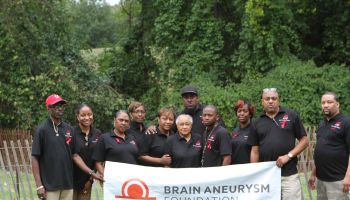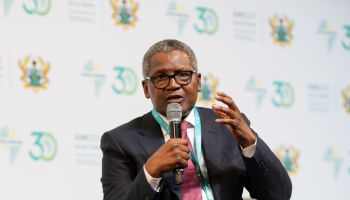
Source: Runner Chancy Brown crosses the finish line at the 2nd Annual Linda McClam Curtis
September is Brain Aneurysm Awareness month. Did you know that an estimated 6 million people in the United States have an unruptured brain aneurysm, or 1 in 50 people? Linda McClam Curtis was no different from you and me. She was a 56-year-old wife, mother, daughter, sister, aunt, cousin, co-worker and friend, whose life abruptly ended on April 5, 2013 due to a ruptured brain aneurysm.
In 2014, her son, Louis Curtis founded The LMC Foundation for Brain Aneurysm Awareness in honor of his mother. The LMC Foundation is a 501(c)(3) nonprofit organization dedicated to working with the Brain Aneurysm Foundation to raise awareness about brain aneurysm, the risk factors, warning signs and the importance of early detection and treatment. Linda experienced multiple warning signs that were repeatedly misdiagnosed by physicians. However, her aneurysm was genetic. Many, in fact, are unaware that this is the case in many instances. If Linda would have known to communicate this with her physicians, she could have received the proper treatment and her life would have been saved.
Join the LMC Foundation for Brain Aneurysm Awareness for the 3rd Annual Linda McClam Curtis 5K Run/Walk on Saturday, September 5, 2015 at East Potomac Park (Hains Point) at 7:30 am to honor those whose lives were suddenly taken by a ruptured brain aneurysm, as well as those who have been fortunate enough to survive this devastating disease.
To register or donate, visit the website.
For more information on the LMC Foundation for Brain Aneurysm Awareness, contact Kimberly Davis at lindaswalk.ba@gmail.com.
All proceeds from this event will go to the Brain Aneurysm Foundation.
Here are a few statistics and facts on Brain Aneurysm from the Brain Aneurysm Foundation:
- An estimated 6 million people in the United States have an unruptured brain aneurysm, or 1 in 50 people.
- The annual rate of rupture is approximately 8 – 10 per 100,000 people or about 30,000 people in the United States suffer a brain aneurysm rupture. There is a brain aneurysm rupturing every 18 minutes. Ruptured brain aneurysms are fatal in about 40% of cases. Of those who survive, about 66% suffer some permanent neurological deficit.
- Approximately 15% of patients with aneurysmal subarachnoid hemorrhage (SAH) die before reaching the hospital. Most of the deaths from subarachnoid hemorrhage are due to rapid and massive brain injury from the initial bleeding which is not correctable by medical and surgical interventions.
- 4 out of 7 people who recover from a ruptured brain aneurysm will have disabilities.
- Brain aneurysms are most prevalent in people ages 35 – 60, but can occur in children as well. The median age when aneurysmal hemorrhagic stroke occurs is 50 years old and there are typically no warning signs. Most aneurysms develop after the age of 40.
- Most aneurysms are small, about 1/8 inch to nearly one inch, and an estimated 50 to 80 percent of all aneurysms do not rupture during the course of a person’s lifetime. Aneurysms larger than one inch are referred to as “giant” aneurysms and can pose a particularly high risk and can be difficult to treat.
- Women, more than men, suffer from brain aneurysms at a ratio of 3:2.
- Ruptured brain aneurysms account for 3 – 5% of all new strokes.
- Subarachnoid hemorrhage (SAH) is one of the most feared causes of acute headache upon presentation to the emergency department. Headache accounts for 1 – 2% of the emergency room visits and up to 4% of visits to the primary care offices. Among all the patients who present to the emergency room with headaches, approximately 1% has subarachnoid hemorrhage. One study put the figure at 4%.
- Accurate early diagnosis is critical, as the initial hemorrhage may be fatal, may result in devastating neurologic outcomes, or may produce minor symptoms. Despite widespread neuroimaging availability, misdiagnosis or delays in diagnosis occurs in up to 25% of patients with subarachnoid hemorrhage (SAH) when initially presenting for medical treatment. Failure to do a scan results in 73% of these misdiagnoses. This makes SAH a low-frequency, high-risk disease.
- There are almost 500,000 deaths worldwide each year caused by brain aneurysms and half the victims are younger than 50.
- Based on a 2004 study, the combined lost wages of survivors of brain aneurysm rupture and their caretaker for a year were $138,000,000
- The cost of a brain aneurysm treated by clipping via open brain surgery more than doubles in cost after the aneurysm has ruptured. The cost of a brain aneurysm treated by coiling, which is less invasive and is done through a catheter, increases by about 70% after the aneurysm has ruptured.
- 10 – 15% of patients diagnosed with a brain aneurysm will harbor more than one aneurysm
Awareness is key. Tell a friend, family member, or neighbor. The life you save could be your own!

Source: Linda McClam Curtis / Keanna Faircloth















